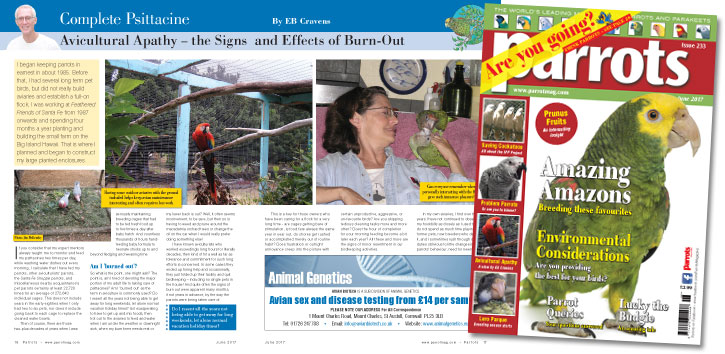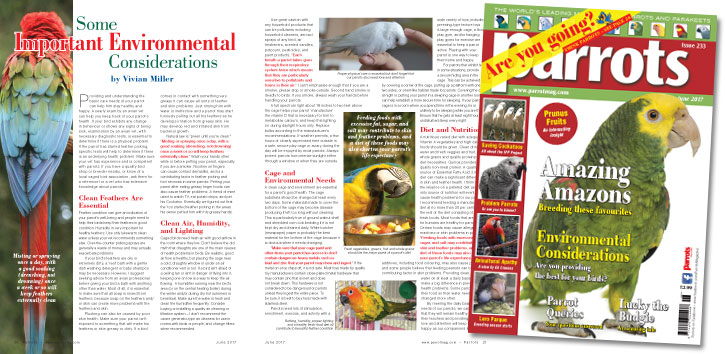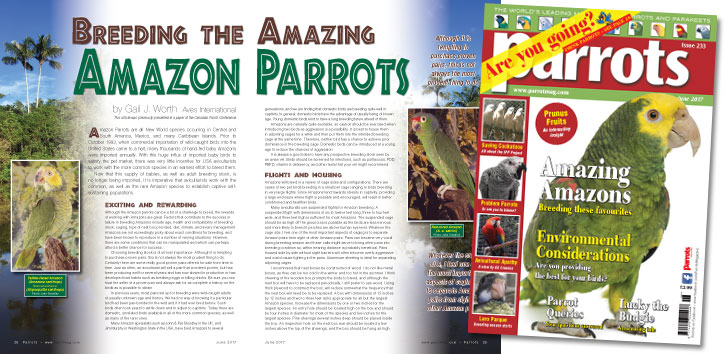
Complete Psittacine by Eb Cravens
I began keeping parrots in earnest in about 1985. Before that, I had several long term pet birds, but did not really build aviaries and establish a full-on flock. I was working at Feathered Friends of Santa Fe from 1987 onwards and spending four months a year planting and building the small farm on the Big Island Hawaii. That is where I planned and began to construct my large planted enclosures.
If you consider that my expert mentors always taught me to monitor and feed my psittacines two times per day, while washing water dishes out every morning, I calculate that I have fed my parrots, other aviculturists’ parrots, the Santa Fe Shoppe parrots, and miscellaneous nearby acquaintance’s pet parrots certainly at least 22,720 times for an average of 272,640 individual cages. This does not include years in the early eighties when I only had two to six pets, nor does it include going back to each cage to replace the cleaned water bowls.
Then of course, there are those two-plus decades of years when I was seriously maintaining breeding cages that had to be fed fresh food up to five times a day after baby hatch. And countless thousands of hours hand-feeding baby formula to neonate chicks up to and beyond fledging and weaning time.
Buy Now!

by Vivian Miller
Providing and understanding the basic care needs of your parrot can help him stay healthy and happy. A yearly exam by an avian vet can help you keep track of your parrot’s health. If your bird exhibits any change in behaviour or shows any signs of being sick, examination by an avian vet, with necessary diagnostic tests, is essential to determine if there is a physical problem. If the parrot has started feather picking, specific tests will help to determine if there is an underlying health problem. Make sure your vet has experience and is competent with parrots. If you have a quality bird shop or breeder nearby, or know of a local caged bird association, ask them for a reference for a vet who has extensive knowledge about parrots.
Feather condition can give an indication of your parrot’s well-being and people need to help their birds keep their feathers in good condition. Humidity in very important for healthy feathers. Use only lukewarm clean water unless your vet recommends something else. Over-the-counter picking sprays are generally a waste of money and may actually exacerbate problems.
Buy Now!

by Gail J. Worth, Aves International
Amazon Parrots are all New World species occurring in Central and South America, Mexico, and many Caribbean Islands. Prior to October 1993, when commercial importation of wild-caught birds into the United States came to a halt, many thousands of hand-fed baby Amazons were imported annually. With this huge influx of imported baby birds to satisfy the pet market, there was very little incentive for USA aviculturists to work with the more common species in an earnest effort to breed them.
Now that this supply of babies, as well as adult breeding stock, is no longer being imported, it is imperative that aviculturists work with the common, as well as the rare Amazon species to establish captive self-sustaining populations.
Although the Amazon parrots can be a bit of a challenge to breed, the rewards of working with Amazons are great. Factors that contribute to the success or failure in breeding Amazons include age, health and compatibility of breeding stock, caging, type of nest box provided, diet, climate, and aviary management. Amazons are not exceedingly picky about exact conditions for breeding, and have been known to reproduce in a number of varying situations. However, there are some conditions that can be manipulated and which can perhaps afford a better chance for success.
Buy Now!

The Holistic Parrot by Leslie Moran
Transforming a love for parrots into a global conservation community
This month we learn how two individuals, Stewart Metz and Bonnie Zimmermann of the Indonesian Parrot Project (IPP), are transforming the illegal parrot trade through their vital work. In the Indonesian tropical rain forests they educate and empower the local people by awakening an awareness and appreciation for the wild parrots who share their rugged and sometimes hostile tropical home. Here we’ll learn how they are bringing a paradigm shift, spanning generations, with the goal of ending the smuggling and mistreatment of wild parrots. As they create win-win situations for everyone involved, they set a stellar example for creating positive change in the world.
“The number of wild Cockatoos and other parrots being captured every year for the illegal wildlife trade is staggering,” explained Stewart, who founded the IPP in 2001. The published sources account for at least 10,000 wild birds being captured every year by illegal trapping in Indonesia.
Stewart recognised right away that the trappers caught wild parrots because they needed to provide for their families. These local men were proud, genuine, people who also had a willingness to learn. They sensed Stewart’s sincerity and respect for them as men, and they learned to trust and respect him in return. This opened the door for them welcoming his insights about the wild parrots and the economic solutions he, and their other partner organisations, offered that would enrich their local communities.
Buy Now!




